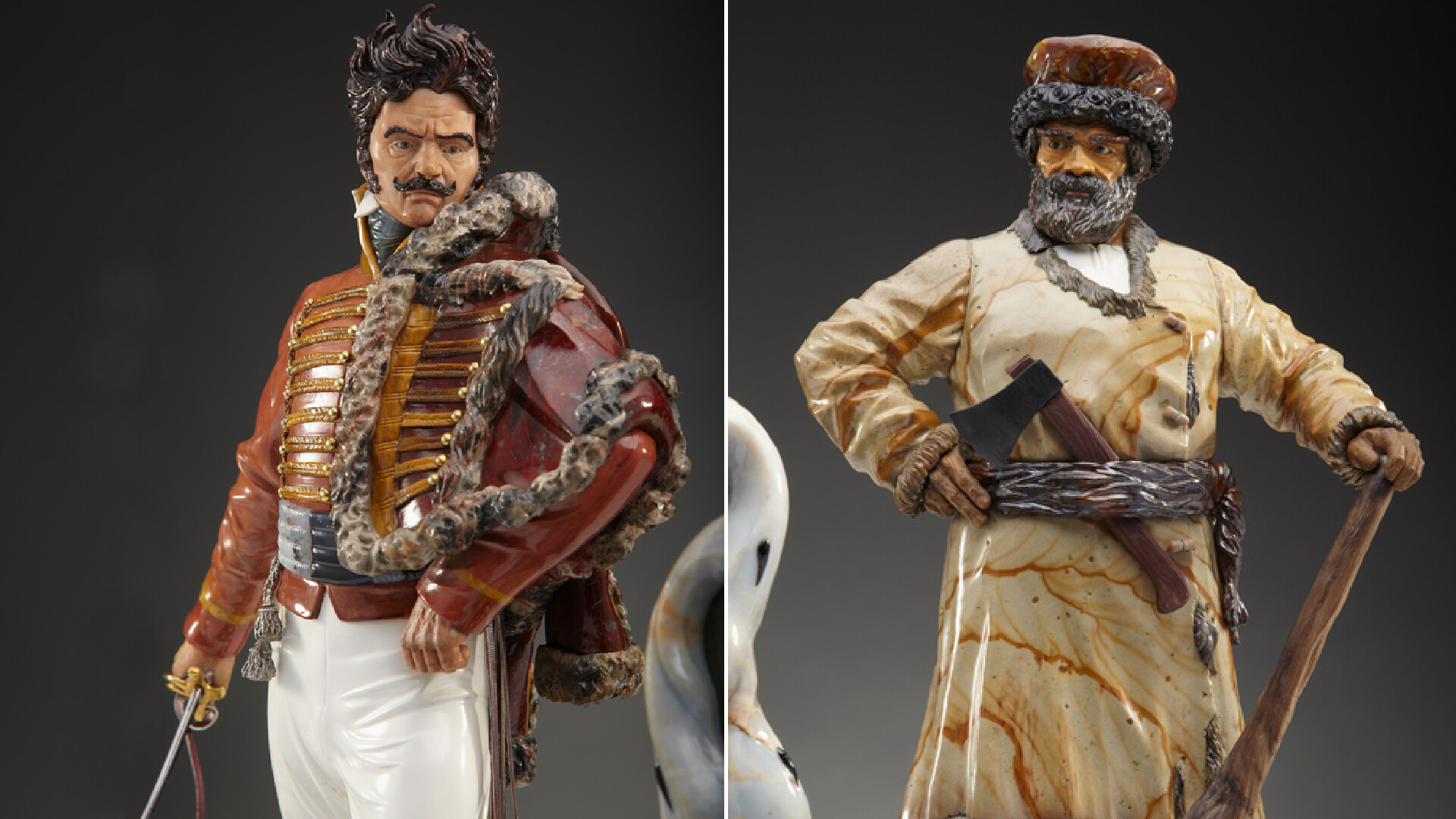
Anna and Oleg Barinovs’ St. Petersburg studio upholds and further develops the traditions of Russian stone-cutting art. Its portfolio is highly diversified: jewelry, small statues, and a wealth of accessories including tableware. A separate genre is animal figurines, those of birds and insects made in accord with Fabergé’s stone-cutting tradition. The studio collaborates with the best artists and stonecutters in their field.
It took over two years to manufacture this unique ‘Panthera’ table clock. Studded with 40 diamonds with a few golden details, the case is made of rare white jade, while the panthera’s gracefully curved body is made of black jade. The delicate work includes even such minute parts as the wild cat’s eyeballs that are made of black faceted diamonds.
Bagulnik Studio in St. Petersburg is the brainchild of Sergey Falkin, one of the most famous Russian stonecutters today. Among the studio’s works are not only classic bouquets, which can hardly be distinguished from real ones, despite being made of stone, but also Florentine-like stone mosaics and folklore-inspired figures, which at some point in time made Fabergé’s firm so famous in the West.
The studio’s craftsmen also boast splendid handmade accessories. The jewel box ‘Bison’ is one of such stone-cut works. The head is crafted from obsidian, the horns from cornelian with an exquisite honey shade, and the eyes are encrusted with garnet grains. The lid, which opens with a click, is made of an alloy of different metals and decorated with a handmade engraving featuring a bison.
This St. Petersburg craftsman is also famous for his stone-carved miniatures. For many years, he’s been working with leading stone-cutting manufactures, as well as creating his own miniatures and a variety of accessories. Vladimir’s works depict an epic saga, coupled with history and an elaborate story that is told.
For instance, this set of three shot glasses, made from rock crystal, features a pond where frogs and lizards are hunting insects. The talented craftsman presents the cut-in-stone enclosed ecosystem as a metaphor for life at large.
All Russian stonecutters know this name very well. Ananyev is not only an outstanding craftsman, but over the past three decades Ananyev has also been a populariser of stone-cutting art in general. Anton loves working with jade. If compared to painting we can say that his works are made with broad strokes. What distinguishes them are abrupt lines, compact presentation and a thoroughly worked-out form.
This silver-mounted photo frame is cut in jade. The composition is extraordinary: the image appears to be inside a crab’s pincers, while the general mood, despite the image’s more or less classic style, resembles that of a science fiction movie.
Along with the St. Petersburg school, the traditions of stone-cutting art continue to be upheld in its historic Russian birthplace, in the Urals. One leading stone-cutting firm, which makes beautiful and elaborate works of art in the technique of a block miniature (parts are cut in different types of stone) is the Svyatogor Studio. It has gathered together outstanding craftsmen who produce sophisticated works, each of which tells a certain story and deserve to be in a museum.
A whole team of craftsmen worked on this writing set ‘The year of 1812’: four stonecutters, three polishers, and three jewelers. The idea belongs to artist Grigory Ponomaryov, head of Svyatogor. The composition is made of jasper, chalcedony, jade, chrysoprase, as well as tigereye, sardonyx, labradorite and magnesium carbonate. The metallic parts are made of silver and gold. The two figures (in the technique of a block miniature) are those of a hussar and a worker – the upper class and the peasantry – who worked together to heroically defeat the French and Napoleon.
Alexander Veselovsky has been in the profession for 20 years and is well-known in Russia and abroad. His works always exhibit vivid imagination and out-of-the-box solutions. His favorite combination of materials is jade and silver.
This ashtray instantly brings to mind the images of Hans Giger. Look, can you see the ‘Alien’ here? The ashtray itself is made of silver, with the base carved in jade.
Veselovsky’s one-of-a-kind works can be spotted in many private collections around the world.
Ekaterinburg’s leading studio boasts unique works of stone-carving art. This miniature, which may be used as a decorative element for a desk or a study room, is one of the key items in the studio’s portfolio. It is the result of the craftsmen’s skilled work and the nonstandard vision that it conveys - something that Alexey Antonov, the studio’s founder, is most famous for.
The joker symbolizes the master of one’s own destiny. The elaborate composition is made of almost a dozen various stones and minerals, including jasper, malachite, dolerite, rhodonite, lazurite, charoite, fluorite, amazonite, lepidolite, apatite, cacholong and crystal. Many of these stones are locally mined in the Ural region.
Dear readers,
Our website and social media accounts are under threat of being restricted or banned, due to the current circumstances. So, to keep up with our latest content, simply do the following:
If using any of Russia Beyond's content, partly or in full, always provide an active hyperlink to the original material.
Subscribe
to our newsletter!
Get the week's best stories straight to your inbox